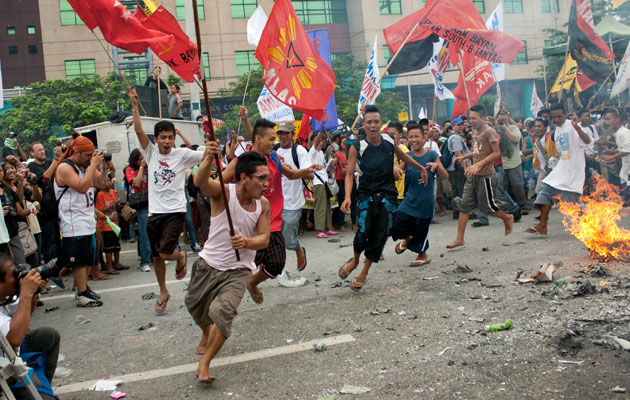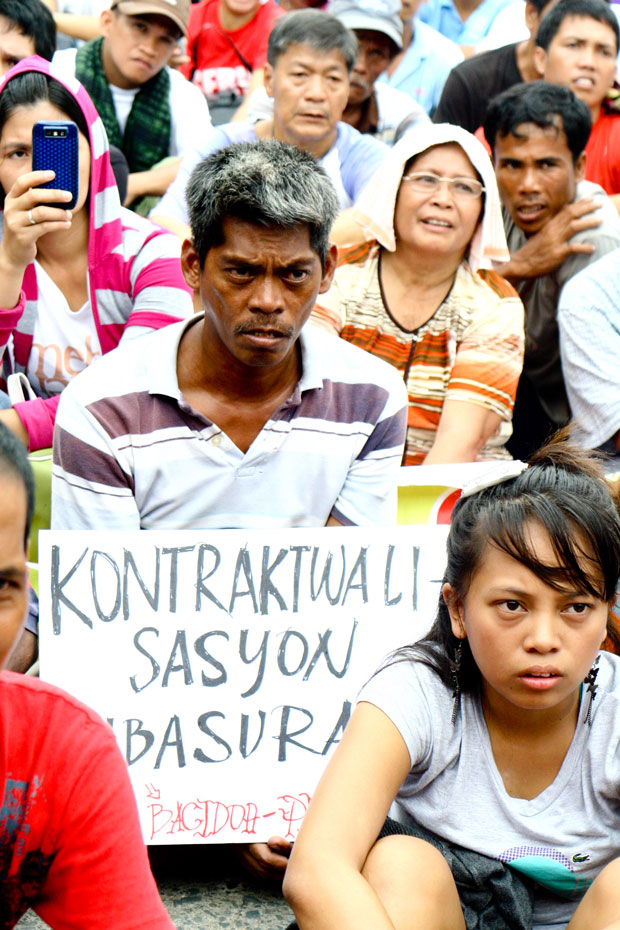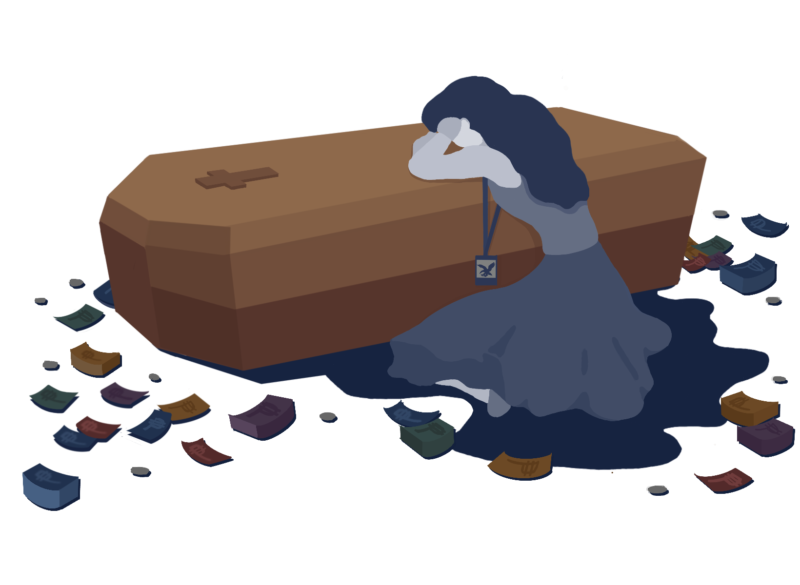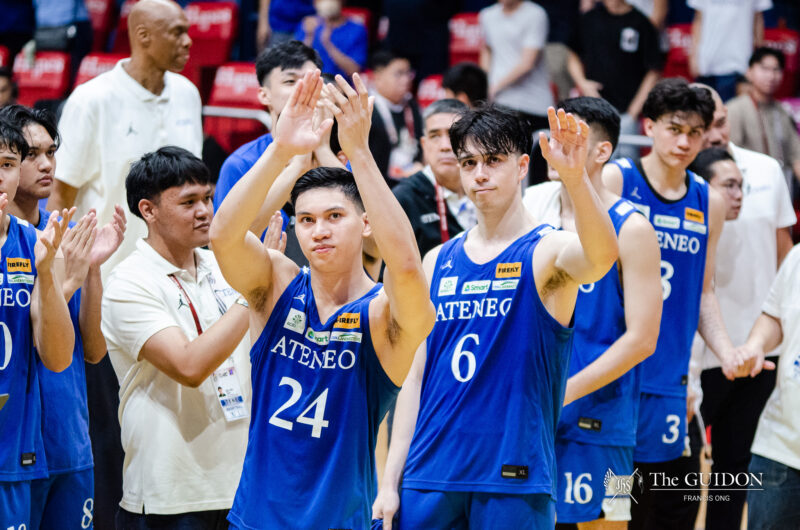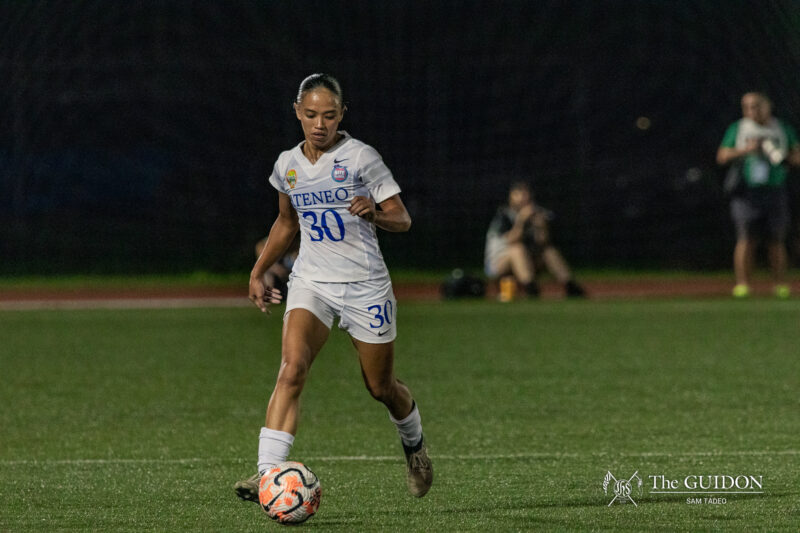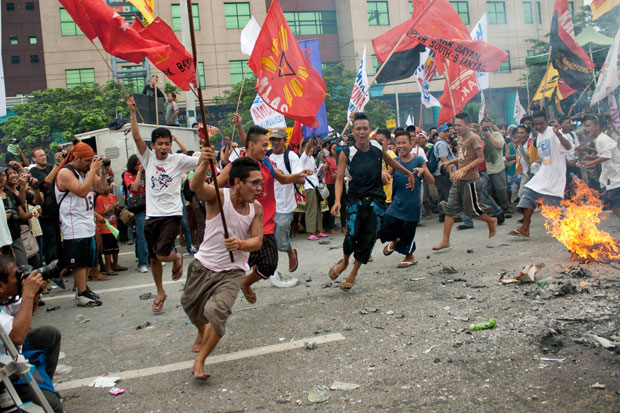
Forty-two-year-old grievances. The militant groups that regularly express disappointment with the government come from the leftist scene that dominated the streets in the late ’60s to early ’70s. Photo by Abram P. Barrameda
Eman Lacaba and Krip Yuson usually drank together at their favorite bar, or when they felt like staying close to campus, at the pool in Cervini Hall—the broken bottles left in the water irked the Jesuits every time. Being the good friends that they were, the two would also occasionally smoke pot together.
Lacaba was particularly interested in the esoteric: astrology, palm reading, and tarot cards. As a sheer college prank, he once stole the sword from St. Ignatius of Loyola’s statue near the Manila Observatory. He asked Yuson to keep it for him for a week.
These two friends seemed destined to be trailblazers on the same path—both had a flair for writing and a knack for the unconventional. But during the dark years of Martial Law, the roads they each trudged slowly but surely separated, leading the two Atenenas towards vastly different directions.
Lacaba eventually joined the revolutionary New People’s Army in the countryside. Yuson, on the other hand, stuck to a safer route. “I was more with the [bohemian crowd],” Yuson explains, though not necessarily taking away the same label from Lacaba. “At that time, [I was] very apolitical.”
Beyond Bohemia
Peace signs, tie-dyed shirts and psychedelic rock dominated the late 1960s. But as the hippie lifestyle became a ubiquitous among the youth, there were those who distinguished themselves by being regulars in street protests. This trend of youth activism manifested across universities, across continents.
In Cristina Montiel and Susan Evangelista’s book Down from the Hill, readers are transported back in time to a crucial period in Atenean history. On November 27, 1968, five students, including Lacaba, published a manifesto in The GUIDON entitled “Down from the Hill.” The historic document made a radical call for Filipinization and stressed the need to make the Ateneo relevant to the Philippine situation.
The manifesto’s writers wanted to change an Ateneo whose whole identity seemed to rely on the whims and fancies of Uncle Sam. Classes were hardly offered in the national language, and everyone spoke in English—it was the golden age of the “Arrneow” accent.
The manifesto, among other things, called for the replacement of the American Jesuits by Filipinos in the top rungs of school administration. For these progressives, though, Filipinization meant more than just paving the way for the birth of the Filipino Department. It was not just about the academics for them, but more importantly, about the Atenean’s whole-hearted partaking in the struggles of the suffering Filipino people. “Down from the Hill” called for an awakened consciousness to the problems that beset the marginalized.
To these progressives, the ills of Philippine society were feudalism, imperialism and bureaucrat capitalism. These three social realities were seen as the evils that oppressed the Filipino masses.
As a result, the spirit of activism, both inside and outside the Ateneo, intensified in the following years. While some started holding moderate leftist views, some were more radical and felt that the desperate situation under Marcos necessitated an approach that wasn’t afraid to match fire with fire. It is with this kind of revolutionary zeal that Jose Maria Sison, with the support of other radicals, officially founded the Communist Party of the Philippines (CPP) on December 26, 1968 at an unassuming barangay in Pangasinan.
“We belong to the tradition of the national democratic and revolutionary youth, who merge themselves with the masses under the red banner of the Philippine revolution,” he explained then at a symposium during those tumultuous days.
Rosa*, a young and prominent member of the rebel movement, having already took to the mountains with the NPA once, remains steadfast to the party goals the CPP outlined more than 4o years ago. She maintains that it is only through great revolutions such as the French Revolution that the ruling class can be overthrown.
Rosa also received her revolutionary education through school experiences, but even UP nowadays is no match for the scenes in the schools during the late ‘60s to early ‘70s. This period saw much political unrest from the youth sector, spearheaded by numerous student organizations. It was the First Quarter Storm, and various student organizations—from that of national democrats to social democrats, radicals to moderates—held violent demonstrations that usually ended in bloodshed.
An underground calling
The infamous date of September 21, 1972 ushered in another era in Philippine history, when then President Ferdinand Marcos declared Martial Law. Numerous rights were suspended, such as the right to freedom of expression and the existence of a free press. The military assumed absolute power and state forces continued cracking down on the anti-government activists in their hit list.
Instead of resigning to the oppression, though, many activists, including some Ateneans, chose to pursue their struggles against the regime instead, and embraced something more radical—they joined the underground forces of the NPA.
Former Congresswoman Risa Hontiveros, an Executive Committee member of the Akbayan Citizens’ Action Party, explains, “It was unavoidable to have armed struggle back then.”
“Any people suffering under a martial law dictatorship will, I think, almost certainly come up with an armed struggle component in [their] anti-dictatorship struggle,” she says.
Lacaba was among the people who eventually saw the futility of unarmed struggle; eventually, he joined the underground resistance of the NPA.
According to Yuson, what led to his friend’s gradual radicalization was initially the political exposure he had during his stint in the Free Press. When Lacaba witnessed the Lapiang Malaya massacre, the trauma the event brought had an even greater effect on his political sensibilities. But the last straw was when his brother Pete Lacaba was detained by the military, after he had helped organize a labor union.
Other Ateneans such as Edgar Jopson, Manny Yap, Billy Begg and Ferdie Arceo, among others, joined in the call for armed struggle.
“[These people] are products of that side of the Ateneo which inculcates social conscience and a strong sense of patriotism and social justice,” Jose Maria Sison says in an email interview. “Not the type that is self-indulgent and bound by the dictates of foreign monopoly interests and the local exploiting classes.”
The winding roads to peace
It was in February 25, 1986 when yellow was born as the new color of hope. The success of the bloodless EDSA Revolution reestablished formal democracy back into the country.
While everybody was happy to see the fall of a tyrant, the national democrats, represented by the CPP, NPA, and the broad radical leftist alliance, the National Democratic Front (NDF), were still dissatisfied. They believed that even though there was no longer a dictator, the continued existence of capitalism, imperialism and feudalism in Philippine society meant the continued oppression of the working class. Hence, for them, the revolution would not just continue—it would escalate.
Twenty-five years and four presidencies after EDSA, the government and the CPP-NPA-NDF are in peace negotiations. For years, though, there has been no substantial progress in the peace process.
“Usually, the war process would overtake the peace process,” Hontiveros explains. “Both aren’t strategically committed to peace—[the government] tended to be counterinsurgent in its reflexes, while the NDF was only after reaching a belligerency status. Both sides must have a paradigm shift in order for [the peace talks] to be successful.” Once the NDF is recognized as having belligerency status, this would, among other things, indicate that it is recognized as a sovereign entity under international law.
Another round of peace negotiations has been started again under President Noynoy’s Aquino’s government. After a fresh set of preliminary talks, the panels agreed to finish the negotiations in a maximum of three years.
If substantial reforms are reached through the peace talks, i.e., if they address the roots of the armed conflict, Sison believes, “The implications and consequences will be drastically different in favor of the broad masses of the people.” However, if the peace talks fail once more, then the armed conflict is bound to continue.
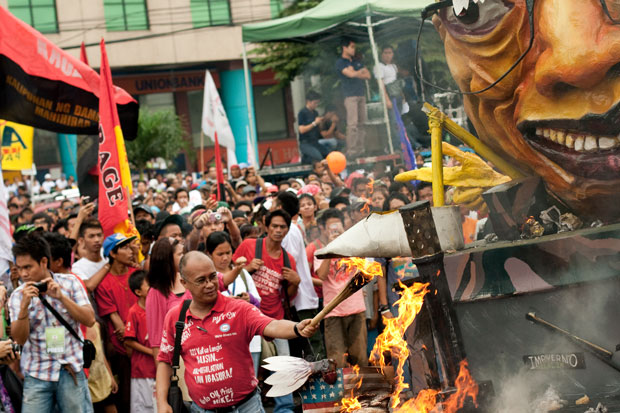
Burned out. A huge group of protesters gathered to express their disappointment with Aquino’s first year. Photo by Abram P. Barrameda.
Lessons from the revolution
The story of the armed struggle has been part of the country’s political narrative for decades now. There is a chance that it might end soon, but it is equally likely that the conflict escalates even further. Amidst all these, the Ateneo finds its relevance in its original vocation: education.
After all, apathy is the real enemy in whatever political milieu one belongs to. Miguel Rivera, party premier of the Christian Union for Socialist and Democratic Advancement, says, “From a student perspective, we have to get involved. [We need] to engage and ask questions about these things.”
Rosa, having been immersed in the countryside where the masses are, says, “The revolutionary movement [learn from] the people at the grassroots—farmers, peasants, laborers—[because they] experience what poverty and oppression are.” However, she continues, “but it’s through education [that] activists can guide the party through theory.”
Hontiveros believes that the Ateneo must provide a healthy environment for educating the critical faculties, especially the political. “I really hope the Ateneo could be more left as it originally was,” Hontiveros says, appealing to her own days in the school, when student activism was still more widespread.
The ‘60s and ‘70s belonged to a generation to whom a crisis was most manifest. Many feared a dictator who had no regard for human rights or liberties, but there were still those who mustered enough courage to have been able to tread the dangerous paths to freedom.
Times have changed, and options now are no longer as black and white as during the time of Marcos. It’s no longer just a choice between utter silence and outright revolt. But if there’s anything that Eman Lacaba did that Ateneans are perhaps challenged to match, it’s his being a trailblazer, an artist, a revolutionary in more than one sense. The Philippines still has a lot of the problems that plagued it during Lacaba’s time, and it would take a degree of creativity like his to solve all of them.
*Name has been changed to protect the individual
What do you think about this story? Send your comments and suggestions here: tgdn.co/2ZqqodZ

